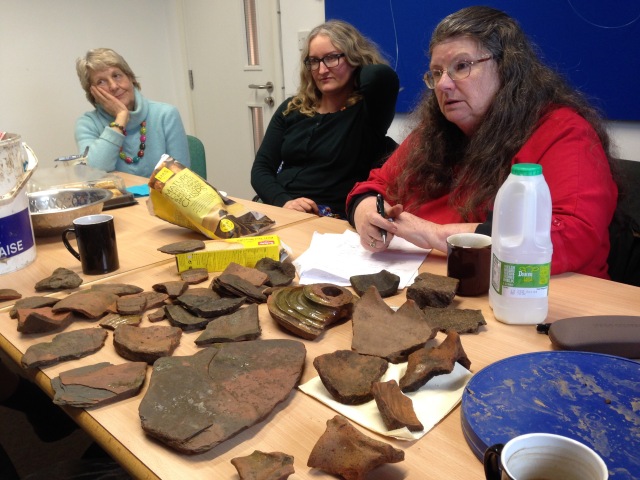Building work on the Memorial Hall in Newport is beginning now and the removal of soil outside the north west corner of the building is producing large quantities of medieval pottery and kiln debris. These are some samples of the finds. 
For more on the origins and earlier stages of the project see my earlier posts from February and December last year. Essentially the site was first excavated in 1921, revealing two late medieval pottery kilns. One kiln was recorded and destroyed and the other was preserved beneath the building in an underfloor space, scheduled and more of less forgotten. A recent Lottery funded project to recondition the hall has brought the whole site back into the light and the preserved kiln will be made accessible to the public eventually. The degree of preservation is remarkable and it is a rare opportunity to study this kind of site in so much detail.
.
All of this is dumping from the original construction of the hall in 1921, mainly into the foundation trenches and includes Edwardian china as well as 15th/16th century pottery. Nonetheless it is giving us a good idea of the range of shapes and types of ware and also some evidence of the way they were packed in the kiln. There is a lot of washing and sorting to do at oresent but the picture so far is of a small range of shapes, principally jugs, deep bowls (sometimes with handles) and range tiles. Alongside those there are signs of jar shapes and one large, heavy base that may be a candlestick – seeming very exotic here. There are no signs of decoration and glaze is used very sparingly which helps to explain why the kiln is so clean.
Fragments of shale including quite large flat weathered pebbles have oxidised impressions of vessels on them and patches of glaze. One at least has clearly been used to separate two levels of pots, having the impression of a pot on the upper surface and of two more on the bottom. Others may have been used to protect the kiln floor and discarded regularly. There are no signs so far of ceramic kiln furniture. As during the excavation of the kiln, pieces of fired clay with finger impressions are common, looking like discarded pieces of pointing.
The pottery belongs to the family known as Dyfed Gravel-Tempered Ware which is found up and down the Welsh coast but is most common in Pembrokeshire and Carmarthenshire. The Newport pottery could have supplied a wide area through the harbour but it is likely that there are other production centres nearby. Two complete pots found nearby in Newport Castle in the 19th century are examples of Dyfed GTW and are reasonably consistent with the pottery we have seen so far.



For more on the origins and the initial re-excavation stage of the project see my earlier posts from February (The Newport Medieval Kiln, Pembrokeshire) and December (Excavating the Medieval Kiln at Newport, Pembrokeshire) last year.






Pingback: Latest News from the Newport Medieval Kiln | Clay and Fire
Pingback: Jars and Jugs from Newport Medieval Kiln excavations | Clay and Fire
Pingback: Newport Medieval Kiln Open to the Public | Clay and Fire